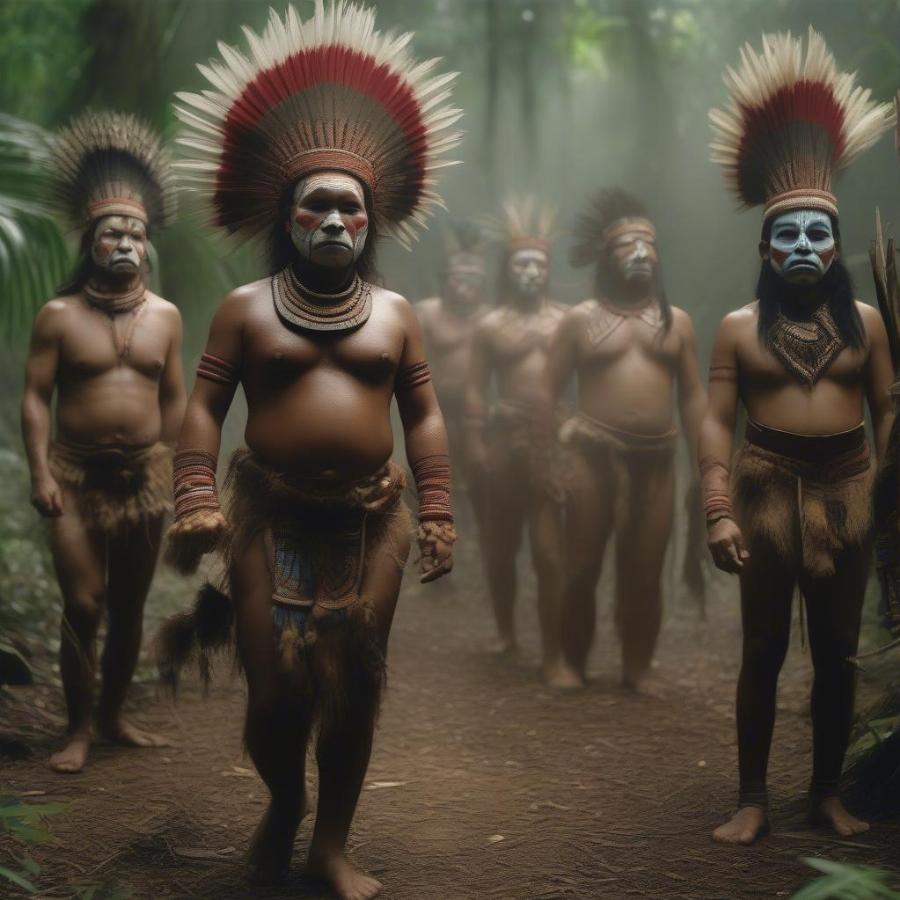The Green Inferno: A Descent into Cinematic Cannibalism

The Green Inferno plunges viewers into the heart of the Amazon rainforest, a world of vibrant beauty and lurking danger. This 2013 horror film, directed by Eli Roth, explores the terrifying consequences of well-intentioned activism gone horribly wrong, echoing the cannibalistic themes of Italian exploitation films of the 70s and 80s.
The Green Inferno: A Modern Homage to Cannibal Horror
Eli Roth’s The Green Inferno isn’t just a horror film; it’s a visceral experience designed to unsettle and disturb. Drawing inspiration from Italian cannibal films like Cannibal Holocaust, Roth crafts a narrative that critiques the naivete of modern activism while delivering shocking scenes of graphic violence. The film follows a group of student activists who travel to the Amazon to protest deforestation, only to find themselves captured and consumed by a reclusive indigenous tribe. The film’s title itself evokes the imagery of hellish, verdant depths, hinting at the horrors that await within the jungle’s embrace.
The film’s impact comes not just from its graphic depictions of cannibalism, but also from its exploration of cultural clashes and the dangers of imposing Western ideals on indigenous communities. The Green Inferno sparked controversy upon its release, with some critics praising its bold approach to social commentary while others condemning its exploitation of indigenous cultures.

A Deeper Dive into the Jungle: Exploring the Themes of The Green Inferno
The Green Inferno confronts viewers with uncomfortable truths about the complexities of activism and the potential for good intentions to pave the way to hell. The student activists, driven by a desire to make a difference, inadvertently become the victims of their own naivete. They fail to understand the nuances of the situation they’re inserting themselves into, ultimately paying a heavy price for their ignorance. The film’s narrative serves as a cautionary tale, reminding us that even the most noble causes can have unforeseen and devastating consequences.
Beyond its social commentary, The Green Inferno also delves into the primal fear of the unknown. The Amazon rainforest, with its dense foliage and hidden dangers, becomes a character in itself, representing the unpredictable forces of nature and the fragility of human life. The film plays on our innate anxieties about venturing into uncharted territory, tapping into the age-old fear of being consumed by something greater than ourselves.

The Controversy Surrounding The Green Inferno: Exploitation or Social Commentary?
The Green Inferno ignited heated debates upon its release, with critics divided on its portrayal of indigenous cultures. Some argued that the film perpetuated harmful stereotypes and exploited indigenous communities for shock value. Others defended Roth’s vision, suggesting that the film’s controversial elements were necessary to convey its message about the dangers of cultural imperialism. The debate surrounding The Green Inferno highlights the challenges of representing indigenous cultures on screen and the ethical considerations that filmmakers must grapple with.
Regardless of one’s stance on the controversy, The Green Inferno undoubtedly sparked conversations about the responsibilities of filmmakers and the power of cinema to influence perceptions. The film’s impact extends beyond the realm of entertainment, prompting viewers to question their own assumptions and biases.

From Cannibal Holocaust to The Green Inferno: A Legacy of Cinematic Cannibalism
The Green Inferno sits within a larger tradition of cannibal horror films, drawing heavily from the Italian cannibal genre of the 1970s and 80s. Films like Cannibal Holocaust and Cannibal Ferox paved the way for Roth’s vision, establishing the tropes and conventions of the subgenre. These films often explored themes of cultural clash, colonialism, and the dark side of human nature, using graphic violence to shock and disturb audiences. The Green Inferno pays homage to its predecessors while updating the formula for a modern audience, incorporating social commentary and exploring the complexities of contemporary activism.
The lasting impact of The Green Inferno lies in its ability to provoke thought and discussion. While the film’s graphic content may not appeal to all viewers, it undeniably leaves a lasting impression.

In conclusion, The Green Inferno offers a disturbing and thought-provoking journey into the heart of darkness. The film challenges viewers to confront uncomfortable truths about human nature and the consequences of unchecked idealism. While the film’s graphic violence and controversial themes may not be for everyone, The Green Inferno undoubtedly leaves a lasting impression, prompting reflection on the complexities of activism and the dangers that lurk beneath the surface of even the most well-intentioned endeavors.
FAQ: The Green Inferno
-
What is The Green Inferno about? The Green Inferno follows a group of student activists who travel to the Amazon to protest deforestation and end up captured by a cannibalistic tribe.
-
Who directed The Green Inferno? Eli Roth directed The Green Inferno.
-
When was The Green Inferno released? The Green Inferno was released in 2013.
-
Is The Green Inferno based on a true story? No, The Green Inferno is not based on a true story, although it is inspired by the Italian cannibal film genre.
-
Why is The Green Inferno controversial? The Green Inferno is controversial due to its graphic depictions of violence and its portrayal of indigenous cultures.
-
What are some similar movies to The Green Inferno? Similar movies include Cannibal Holocaust, Cannibal Ferox, and other films within the Italian cannibal genre.
-
Where can I watch The Green Inferno? The Green Inferno is available for streaming on various platforms and can also be rented or purchased.
-
What is the significance of the title “The Green Inferno”? The title refers to the Amazon rainforest as a place of both beauty and danger, a “green hell” where the activists face unimaginable horrors.
-
What are some of the key themes explored in The Green Inferno? Key themes include activism, cultural clash, the dangers of naivete, and the primal fear of the unknown.



